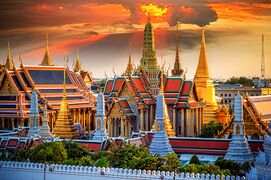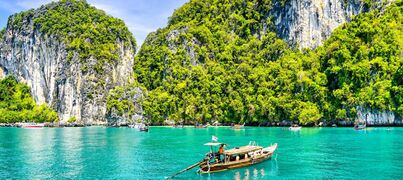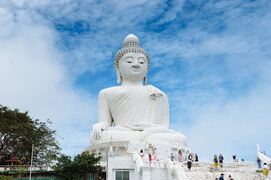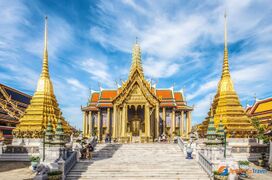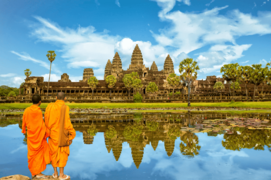Thervala
Thervala ("The Kingdom of Thervala") Ratcha-anachak Ther (Ther) | |
|---|---|
|
Flag | |
Motto: ชัยชนะด้วยเลือด ("Victory through blood") | |
Anthem: | |
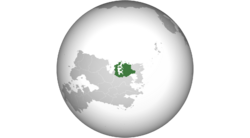 Location of Thervala (dark green) In Audonia (gray) | |
| Capital and largest city | Wat Kram |
| Official languages | Ther |
| Demonym(s) | Ther (noun) Ther (adjective) |
| Government | Constitutional Monarchy |
• King | Ananda Varma II |
• Prime Minister | Chatchai Suriyawan |
| Legislature | National Assembly |
| Senate | |
| House of Representatives | |
| Establishment | |
| Population | |
• Estimate | 80,000,000 |
| GDP (PPP) | estimate |
• Total | 23,000 |
| GDP (nominal) | estimate |
• Total | 560,000,000 |
• Per capita | 7,000 |
| Gini | Your gini coefficient Error: Invalid Gini value |
| Currency | Rathan (RTH) |
| Driving side | right |
'Thervala' (Terwalaah), officially the 'Kingdom of Thervala', is a constitutional monarchy in Audonia. It is neighbored by Oyashima and Metzetta
Although the modern state that is the Kingdom of Thervala has only existed for a few centuries, people have been living in that region of Audonia since prehistoric times. Archaeological findings that date back to prehistory are sparse, but what has been found suggests that the prehistoric Ther people were a religious society, potentially theocratic in nature. It is also known that this prehistoric society subsisted largely off of trade and fishing.
The borders of the Kingdom of Thervala have remained consistent since the forming of the original Vishran Dynasty. The historical kingdoms of Thervala have either been ruled by foreign dynasties or vassalized under stronger foreign powers. It was not until the 20th century that Thervala became a completely autonomous nation. This process was done in mutual cooperation between Burgundie and Thervala. Some academics argue that the modern state of Thervala is still under the thumb of Burgoignac rule, but a majority of academics see this as another form of the famous Global Burgieman conspiracy theory.
The earliest recorded state in the region was a Peshabi dynasty of nobles from the Arunid Empire known as the Vishran Dynasty. They came to the Ther region of Audonia in 200 BCE. The Vishran Dynasty introduced written language and civilization to the indigenous Ther population. Much of ancient Ther culture was adapted from the Peshabi culture of the Vishran Dynasty. This process is academically known as Arunidisation. The Vishran dynasty came to its eventual end due to the conquests of the Myanga Ayil Khanate. The capitulation of the Vishran Kingdom was largely bloodless, except for the Peshabi ruling class, who had become infamous for their hedonism and brutal style of ruling.
Because the Ther were collaborative with the Great Khan, the Khram dynasty was installed as a vassal under the Khanate in 1300 CE. This dynasty was responsible for the founding of the Kingdom's capital city, Wat Khram. The Khram dynasty also issued edicts in regards to the development of the kingdom's civil and legislative codes and made the state religion Theravada Buddhism. Thervala traces its martial culture to the Khram dynasty, as part of the vassalization required the dynasty to provide the Khanate with a steady supply of well trained and well supplied troops to assist in the Khanate's conquest of Audonia. Ther academics argue that Thervala was integral to the Khanate reaching its zenith in the 14th and 15th centuries. This is largely attributed to the extended use of Elephant cavalry and manpower that Thervala expended as tithe to the Khanate.
The Khram dynasaty were loyal to the Khanate for centuries, largely due to the protection that was provided as well as the Khanate's laissez faire policy towards Ther self-determination and national identity. As conquests started to take a toll on the Ther population, a sentiment for independence began to develop. It wasn't until 1650 that the Khram dynasty came into contact with the Duchy of Martilles and the Martillien North Levantine Trading Company (MNLC). Upon establishment of diplomatic missions, the Khram dynasty was more than willing to act as a collaborative force against the now hated Khanate.
As a protectorate of the Duchy of Martilles, Thervala went through the process of Occidentalization, with the MNLC supplying and funding the Khram dynasty with state of the art arms and armor, as well as modernizing the Kingdom's administration. Despite the Khram dynasty's cooperation with the Dutchy of Martilles, the stipulations in the establishment of the protectorate stated that a new and more subservient dynasty must be installed, due to the highly nationalist sentiment that had developed within the Khram administration. After a holistic investigation of the Khram dynasty's clans, the MNLC selected a cadet line known as the Sukhavijaya. The new king, Suriyavarman, worked closely both with MNLC and the neighboring Yuganagawa Protectorate, administered by the Duchy of Marialianus' Ularien Trading Company, in battles against the Myanga Ayil Khanate. This close relationship with Maritime Dericania and their Oyashimane protectorate has influenced modern Ther culture immensely, with many loan words coming from Burgoignesc and Oyash.
The Sukhavijaya dynasty is widely seen as the founding dynasty of modern Thervala. Suriyavarman worked very closely with the MNLC to completely modernize the country from the ground up. He expended a good amount of the royal treasury into hiring Burgoigniac scholars to come into the country and translate texts from the Occidental world into Ther. As such, a wealth of treatises on politics, philosophy, medicine, and science became available to Ther nobility.
After Ther decolonization, the Sukhavijaya dynasty ended with the abdication of King Anantadeva. After the abdication, the Ther nobility selected a noble from the Varma-Khram dynasty, which was another cadet line from the then defunct Khram dynasty. The newly selected king, Ananda Varma kept close relations with Burgundie and has helped maintain Burgoigniac interests in Audonia, most notably in the war effort during Operation Kipling. During this time, Burgundie armed, trained, and funded the Kingdom's army. Due to the militarization of the country, a royalist, anti-communist military dictatorship was installed. Although the king was recognized as the head of state, the military junta had total control over the government. This military dictatorship lasted until 1980, when a coup installed a democratic, civilian government.
The King of Thervala no longer has any power on paper, but is very much still the de facto ruler of the nation. In many ways the current civilian government is largely symbolic, due to the Royalist party's stranglehold on the upper and lower houses. Political movements that aim to dislodge the Royalist gridlock usually lead to mass arrests under Lèse-majesté and sometimes assassinations. Thervala's far reaching Lèse-majesté laws are a result of its decades long military dictatorship and its close involvement in Operation Kipling.
Thervala is a member of the League of Nations.
Etymology
The Ther people are the indigenous ethnic group of Thervala, and in the Ther language “Ther” directly translate to “Person” or “People”. “Vala” in Ther is an honorific title meant to denote a holiness or purity. Thervala is then representative not only of the borders of the country itself, but also its people. The Land of the (Holy People).
History
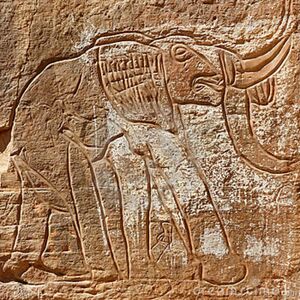
Prehistoric Age
In prehistory, Thervala was comprised of small, religious tribes that lived in fishing communities in and around the East Audonian wetlands. A majority of what is known from this time period comes from bog bodies found in and around swamps near major pre-historic settlements. It is heavily theorized that these bog bodies are instances of ritual sacrifice. Bodies of prehistoric man are not the only things preserved by Thervala's many swamps. Due to the large amount of marshlands in the country, there have been many prehistoric fauna that have been preserved in Ther bogs. Such discoveries have made Thervala a hot spot for zoological and anthropological archaeologists alike.
Aside from bog preservation, Ther archaeology is typically centered around a handful of sites where there were once prehistoric communities. The largest and most famous of which has been dubbed "Chang City" due to the amount of Ivory found in and around the site as well as many unearthed murals depicting Elephants. A large amount of cultural artifacts, mosaics, and jewelry have also been found within the site at Chang City, leading to speculations that it was a prehistoric trade hub.
Arunidisation
In the 4th century BCE Buddhist princes that were expelled by the Zoroastrian Emperor of the Arunid Empire Aadesh. These landless princess followed historical Arunid trade routes until they came upon the Ther people in the far north of Audonia. Upon discovering the indigenous and underdeveloped Ther people, the Arunid princes thought it was their religious duty to enlighten the Ther. They introduced written language to the Ther people and divided the land into realms that would be distributed among the princes. Historically, these entites existed more as monarchal city states that coexisted peacefully with one another.
As the Vishrani princes started to die, the initial realms that were created and distributed equally started to be inherited by the eldest prince of the Vishran dynasty, Habass. Habass eventually outlived all of his brothers and inherited all of the realms. This happened solely because he had chosen to enter into a monogomous relationship wheras the other Vishran princes were notoriously polygamists. Habass was the only one who could definitively inherit titles because the other princes never selected wives that could rule as regents or give heirs.
Habass named the new and united kingdom "Thervala" from the native language of the Ther people. This was to keep records consistent between written Arunid and Ther. Habass ruled benevolently over Thervala and allegedly lived to be 120 years old. The historicity of this claim is dubious at best as most records from the time were lost during the Myanga Revolts. Much of the history of Habass and his reign is heavily mythologized in Ther folklore and culture. In Ther folk tradition, Habass was a hero who slew the native Ther fish god and released the Ther people from its rule.
Vassalization under the Myanga Ayil Khanate
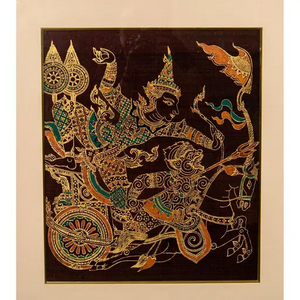
In return for not being conquered, the Great Khan demanded a large contribution of Ther manpower to swell the ranks of his armies. Most scholars tend to agree that Ther military culture was born out of Thervala's vassaliazation under the Khanate. Historical accounts describe divisions of Ther soldiers as incredibly well disciplined and fierce in battle. Ther were typically used as shock troops who specialized in skirmishing and harassment of the opposing army's backline.
One boon of having Thervala as a vassal was Thervala's large population of elephants. Archaeological evidence of Ther Elephants have been found all over Audonia, far outside of their regular habitats and in much greater quantity than trade would permit. There are also written records corroborating the introduction of elephants into the Myanga Ayil Khanate's armed forces as shock cavalry. Some records also report Ther Elephants being used as work and pack animals, due to their capacity to carry large amounts of resources.
The Ther people of the time were largely supportive of the Khanate, due to the reorganization and training of the army in a more modern and standardized capacity. The Khanate was also relatively lenient on taxation and intervention within internal Ther politics. This, however, was not long to last, due to the sheer amount of manpower demanded from the Ther people. Some scholars estimate that the male population of the country shrunk to as little as 35% during the kingdom's time as a Vassal.
Burgoignac Protectorate
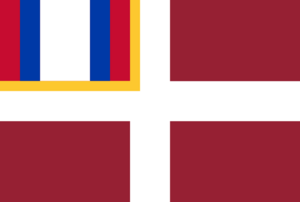
After the defeat of the Myanga Ayil Khanate, The Kingdom of Thervala upheld a treaty signed with the Duchy of Martilles and the Martillien North Levantine Trading Company wherein the Duchy had exclusive rights to trade with and extract resources from the Kingdom of Thervala. In return, Thervala would be Occidentalized, receiving a complete overhaul of the armed forces as well as access to Occidental works pertaining to science, religion, history, and art.
Many of Thervala's largest port cities were founded during this time, including Wat Khram. Wat Khram was founded in a joint venture between the Royal family of Khrima and the Duchy of Martillies to ensure that diplomatic ventures between the two entities wouldn't require long treks through Thervala's jungle. Preexisting cities in the inland areas of the nation were redeveloped to better accommodate intercity commerce, and to ensure that large amounts of goods could be brought towards the port cities for exportation in a much more efficient manner. Before this, they would have had to rely on small caravans traversing Thervala's difficult terrain.
Due to Ther cuisine's abundance of peppers and spices, the kingdom entered into a lucrative trade agreement with the MNLC. Upon Occidentalization, Ther nobility were able to establish large spice plantations which were able to produce peppers and spices en masse. The MNLC also procured land to create spice plantations which were notoriously brutal in their operations. MNLC employees were known to beat, whip, and potentially maim underperforming laborers and their families. Although, some researchers claim that these actions were a reality on Ther owned farms as well.
Military Dictatorship
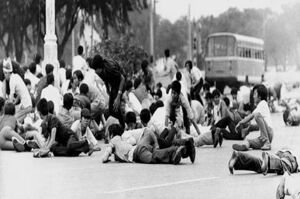
After the coronation of King Ananda Varma I, there was a widespread sentiment for Democratic Socialism in Thervala. Post modernists of the time believed that the monarchy was an outdated institution and that a laity government should be installed. These thoughts were largely influenced by Communist and Socialist thought that had been permeating throughout Audonia at the time. In response to the growing civil unrest and student lead Communist agitation, a state of martial law was declared. An assortment of officers lead by General Prasatthong Kittisak then declared an emergency seizure of power from the king in order to protect him.

After the Kingdom entered a state of emergency, widespread arrests of democratic, communist, and socialist leaders were made. This culminated in a massive riot in Wat Khram. During the riot, small arms fire broke out between the protestors and the Wat Khram Police Department (later reinforced by the Royal Ther Military). This subsequently lead to the 1960 Wat Khram Massacre, where the RTM opened fire on the protestors with military grade weaponry.
This massacre lead to outrage across Audonia, and is considered to be one of the leading causes for the Communist lead conflicts that erupted all over the continent. Domestically, it lead to a coalition between the Democratic, Socialist, and Communist movements in Thervala which was known as the Ther Democratic-Socialist Alliance (TDSA). The TDSA would later radicalize and fully embrace Communist thought, developing into the Ther Freedom Party.
The government's response to the Wat Khram Massacre was to formally outlaw Communist and Socialist organizations within the country as well as severely restrict free speech associated with democracy. The TFP was labeled as a terrorist organization, and its leaders became the most wanted people in Thervala overnight. Most of them fled the country to neutral Metzetta and flew from there to Geisenroda, where they were able to seek political asylum. The TFP in Thervala was then quick to recruit peasantry en masse in the rural provinces of Thervala and form the Red Army of Thervala.
The Red Army of Thervala proceeded to launch a campaign of bombings and skirmishes against the military junta. This lead to a long-term Communist insurgency in the country and acted as a flashpoint between the RTM and the TFP. A conflict which would later bleed into Operation Kipling and inspire Thervala's extensive involvement in it. Burgundie was quick to side with Thervala and offer military and financial aid to the country, even going so far as to recognize the legitimacy of the military junta.
Throughout Operation Kipling, Thervala delegated a majority of its armed forces towards supporting the Liberty Coalition. While the Ther Army provided a lot of manpower towards offensive counter-insurgency efforts in Kandara and Umardwal, a majority of TRA resources were allocated towards occupying and administrating areas afflicted with AudCom-backed paramilitaries. A majority of Ther counter-insurgency operations were performed by Royal Ther Marines. Actions performed by the Ther Military at the time were under reported on, especially in Thervala. Some atrocities committed by Royal Ther Marines would not be acknowledged by the monarchy or Ther government until the mid 2010's.
Thervala's involvement in Operation Kipling and role as a springboard for troop movement into eastern Audonia lead to great economic stimulation in the country. Contemporary fascist thinkers in Thervala attribute the modern Ther economy to the mobilized wartime economy and increased levels of commerce that came with it. Despite his death in the 1980 Ther democratic coup and ruthless persecution of liberal thinkers, many Ther people see Marshall Kittisak as a national hero.
Post Kipling
Bubble Economy
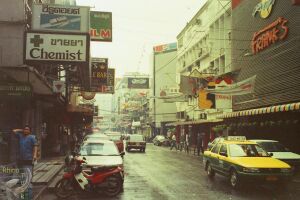
After the establishment of a democratic government and the restoration of the monarchy as the supreme administrative authority in the Kingdom of Thervala, the nation entered a long period of stability and relative calm. This era was marked by significant economic changes driven by various policy reforms aimed at encouraging growth and attracting investment.
The democratic government introduced several measures to stimulate the economy, including easing access to credit, which allowed both individuals and businesses to obtain funding more easily. They also implemented substantial tax cuts, increasing disposable income for citizens and encouraging corporate investment. Additionally, the deregulation of various sectors created an environment that supported entrepreneurial activities and innovation.
As a result, Wat Khram became a financial hotspot in Northern Audonia. The Kingdom's lax economic policies and identifiable tax loopholes attracted a wide range of domestic and international investors. This influx of capital led to a sharp rise in stock prices, reflecting increased market confidence and corporate expansion. Consequently, Thervala experienced an economic boom, with significant growth in sectors such as finance, real estate, and technology.
International and domestic invesetors flooded the Ther stock market, with stocks from Ther companies reaching unprecedented highs. Thervala's stock market was no longer measured by the success of its companies, but from speculation and confidence. Property values in Wat Khram, Wat Vishram, and Sattabhaya skyrocketed, leading to entire neighborhoods being razed and rebuilt to cash in on the burgeoning success in the economy.
Thervala adopted a heavy consumer culture throughout the 1980s. Many Ther companies benefited greatly from the economic climate of the times, and many of Thervala's most beloved entertainment industries were born. Most notably, Surasan released the Chaocon. It was one of the first ever home computers exclusively meant for running video games. Voralex would also spring onto the scene with its Nexar, a direct competitor to Surasan.
Ther economic prosperity only lasted through the decade, the 1991 North Audonian Financial Crisis to rapid deflation of the economy in the 1990s. This was due to a lack of foreign currency entering the country, leading to the government not being able to support it's currency peg to the Taler. The country's economy spiraled overnight due to investers pulling out of the country in droves, causing one of the largest instances of capital flight in history. The kingdom had to take on a massive amount of foreign debt to stabilize the country and bail out domestic banks at the cost of Stipends for Kipling veterans and pensioners.
Post-Bubble Stagnation
Throughout the 1990s crime skyrocketed in Thervala. The monarchy enacted the State Police Act of 1992 to combat this, which replaced local and municipal police forces with Royal Ther soldiers. While this action did bring relative stability to Thervala as well as help to decrease the crimerate, the Royal Ther Army Police became infamous for extorting provincial towns for large sums of money. Thervala oversaw the end of the 99 year Burgo-Ther military lease in the winter of 1992, many Ther people saw the departure of Burgoignac Security Forces as the end of an Era for Thervala.
In 1995 the Ther government enacted the Royal Ther Inernational Diplomatic initiative. Seeking to revitalize Thervala's economy through means of tourism, Ananda Varma I created a million Taler fund for Ther cooks and restaurantiers to go abroad and open up authentic Ther cuisine. The government hypothesized that this would spark interest in Thervala in the far reaches of the globe where it might be unheard of. By and large, this is now considered to be a great success as Ther cuisine is household knowledge worldwide. At the time, however, it was seen as a very strange decision.
One of the more infamous results of the Ther economic bubble popping is the widespread prostitution that occured directly thereafter. Prostitution was formerly competely outlawed in Thervala, due to the highly religious nature of the country. Many foreign investors and businessmen had been sentenced to long tenures in prison due to the solicitation of prostitutes during the bubble economy. This became a much bigger problem when the economy crashed and was exacerbated due to the RTAP's corruption. As much as 60% of the RTAP in Wat Khram frequented Brothels or Street girls during their time as the acting police force. To combat this and potentially help the economy, the government decided to fully legalize prostitution. This helped to protect the rights and safety of working women as well as their ability to set their prices.
Geography
-
Wat Khram at sunset
-
Phin Krat, a popular tourist destination - the largest island in the inner Ther peninsula
-
The National Buddha of Thervala, located on the outskirts of Wat Khram
-
The Imperial Palace of the Khram Dynasty
-
Wat Vishran, the ancient capital of the Vishran Kingdom
Climate and environment
Thervala is a subtropical nation with a large amount of marshland on its mainland Audonian territory. A mountain range to its south makes up a natural border between The Kingdom of Thervala and its bordering nations. The central part of the nation is largely tropical and is comprised of the main Peninsula of Thervala which has over a thousand islands. In the southwest of the country is the Thrak'Tee river. The Thrak'Tee river flows from central Audonia all the way to Wat Khram.
Government and Politics
The Kingdom of Thervala is governed by a de facto democratically elected civilian government but a de jure military government via majority seats in government.
Executive
The King of Thervala is largely a figurehead, but still retains a handful of executive functions and remains influential over the legislature. The main wielder of executive power in the country is the prime minister, who is an elected representative from the legislature. A majority of legislation drafted and passed by the legislature is written "in the interest" of the king.

Legislative
The legislative branch of the country is made up of an upper and lower house, which are comprised of elected officials from the various political parties of the country. Each political party elects a representative who will then run for the position of prime minister.
Federal subdivisions
The Kingdom of Thervala is comprised of ten provinces. These provinces' borders were created when the Khram dynasty was initially installed and are representative of the ten precepts of Buddhism. Each province is granted seventy seats in the Parliament.
Politics
Thervala has a handful of major political parties that ebb and flow in power. However, since the 1980 democratic coup, the ruling party has been the Royal party. The other major parties that have consistently held seats in the Ther parliament are the Fascist Party of Thervala (FPT), Thervala Social Democrat Party (TSDP), and the Green Party.
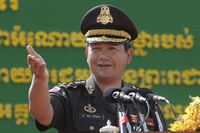
Communism and Socialism are completely outlawed in the Kingdom of Thervala. There was a large scale communist insurgency in Thervala during Operation Kipling that resulted in a handful of terror attacks, widespread skirmishes in the Ther jungle, and the banning of the political party in Thervala. Thervala does have an unofficial communist government in exile, the Ther Freedom Party (TFP). This party was founded alongside members of the Ther communist paramilitary and domestic terrorist organization, the Red Army of Thervala (RAT).
Law
Thervala is infamous the world over for its extremely harsh legal system. It employs torture of all kinds and has a sentencing rate of 97.5%. Prisons in the Kingdom of Thervala are also incredibly strict, regimented, and allegedly rife with human rights abuses. In Thervala, there is no separation between the military and law enforcement, they are one in the same. Thervala has an incredibly low crime rate due to its incredibly strict punitive measures.
Demographics
Ethnicity
Self-reported ethnic origin in the Kingdom of Thervala (2030)
The majority ethnic group in Thervala is the Ther people, followed by Daxian Ther (Daxian merchants that historically settled in Thervala during its time as a Burgoigniac Protectorate. As such, there is also a growing population of Bergendii people in Thervala, due to the historically close ties the two nations have. A good amount of foreign skilled labor comes either from Burgundy or Thervala's fellow Burgoigniac Protectorate and neighbor, Oyashima.
There is also a small community of Peshabi people in Thervala that are descended from the original Vishrani settlers of the region. They face social ostracism and are treated as second class citizens to this day. Such treatment is the root of some concerns had by the League of Nations and human rights organizations.
The rest of Thervala's population consists of immigrants from neighboring Audonian nations such as Metzetta and skilled labor from nations in Levantia.
Language
Ther is the predominately spoken language in Thervala. Due to the kingdom's historic ties with Burgundie, Burgoignesc is a common second language as it is required by law to be taught in school. Oyash and Daxian are also spoken in Thervala, usually within immigrant communities.
Religion
The Kingdom of Thervala is a predominately Theravada Buddhist nation due to it being the state religion. However, there is a large Confucian base in the country. Also, due to Burgoignac influence, there is a sizable population of Mercantile Reform Protestants in the country.
Culture and Society
Education
The Kingdom of Thervala has compulsory school attendance. The government pays for both primary schooling and higher education. This process is based solely on merit, so higher education is incredibly competitive. Royal military personnel are virtually guaranteed a position within a Ther university post service.
Attitudes and worldview
The Kingdom of Thervala has a longstanding religious tradition and Theravada Buddhism is integral to Ther culture and society.. Due to Thervala's intense adherence to religion and stratified, monarchical society, it is known for being one of the most collective countries in the world. Each and every Ther citizen views themselves as having a role in society and they must perform their role to the best of their abilities. Because of this, military service is an incredibly esteemed profession and the Royal Military is never in short supply of new recruits.
It is not uncommon in Thervala to see the old and infirm working menial jobs on the street. Work and responsibility to one's family is paramount to the Ther, even during sickness and old age. Such responsibilities can only be abandoned in the gravest of circumstances, such as intense or terminal illness.
Kinship and family
For the common person family is very important, a majority of people live in multi-generational households and even maintain close relations to distant family. For the upper class, there is a quasi-cast of nobility that has survived since the original Khram dynasty. There are many noble families that maintain high ranking positions within Ther society. There are even some Peshabi people alive today who can trace their ancestry back to the court of the Vishran Dynasty.
Cuisine
Ther cuisine is very diverse in terms of cooking style and ingredients. Ther dishes tend to consist of hot peppers, vegetables, rice or noodles, and a meat of some kind. Ther cuisine is, however, incredibly diverse due to influence from Arunid, Central Audonian, and Burgoignac cuisines. It is considered to be one of the most delicious and flavorful cuisines in the world. Ther restaurants are beloved and renowned worldwide thanks to the Government's movement in the early 2010's to train and subsidize up-and-coming entrepreneurs so they could open up Ther restaurants around the world. The Ther government refers to this practice as 'Gastrodiplomacy', and it is now considered to be a wildly successful strategy. Some notable examples of Ther dishes are as follows: Ther Curry, Pad Ther, Krat Wi Dap, and Bahn Mip.
Religion
Vattayan Buddhism
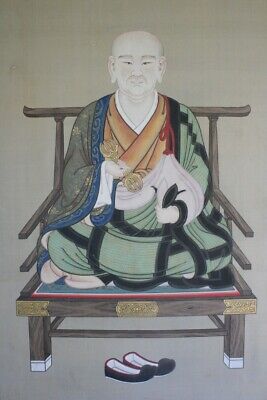
Buddhism was brought to Thervala around 300 BCE when Arunid princes introduced it to the indigenous Ther people. As such, Buddhism is vital to Ther culture and identity, every Ther monarch since the establishment of the Kingdom has been a Buddhist. The Buddhism practiced in Thervala is known as Vattanaya Buddhism. It is unique in that it encourages just killing (such as killing in self defense, in war, and as a method of execution) to accelerate the cycle of death and rebirth so that more people can achieve Nirvana faster. Suicide, however, is considered to be the penultimate form of sacrilege. It is suggesting that one has decided that they have learned and experienced enough in their own life and are ready to move on to the next.
In Thervala euthanasia, capital punishment, and sometimes abortions are all overseen by Vattayan monks. In instances of capital punishment and euthanasia, the monk will personally kill the recipient whilst uttering blessings upon them. To Vattayans, it is considered a great honor to receive the death penalty or to be euthanized, as one will then re enter the cycle of death and rebirth so one may once more have a chance at attaining enlightenment.
Due to the nature of Vattayan Buddhism, the Ther Military is a venerated institution within the religion. Many Vattayan monks in training go through a phase where they are temporarily laification so that they have an oppurtunity to spend time within the Royal Ther Military. Such a tenure is required to become a full fledged Monk. During Operation Kipling, many saints and martyrs were proclaimed due to the actions of Vattayan soldiers and marines serving within the Ther military. There have even been instances of career officers retiring from their positions later in life to become monastics in their final years. The Vattayan schools celebration of historic Ther war crimes have been a source of diplomatic tension between Thervala and other countries.
The Vattayan school of Buddhism was founded by a Ther monk known as Lai Kin Kut. Not much of Lai Kin Kut's early life or his acts have been recorded. It is known that around the middle of his life he was brought to the court of King Chatkra Krahm I. Lat Kin Kut had developed a celebrity status amongst Buddhist scholars and laity alike due to his alleged performance of miracles as well as his profound wisdom. Lat Kin Kut acted as a political and spiritual advisor for the king. His actions in the court garnered him a following of pupils that wanted to learn from his wisdom.
With permission from King Chatkra Krahm I, Lat Kin Kut alongside ten of his most trusted disciples departed the royal court. Lat Kin Kut was given a parting gift from the king, an endowment to build a monastery on the outskirts of Wat Vishran. For the rest of his life, Lai Kin Kut presided over the monastery and produced many monks. Near the later end of his life, a small council of elders was formed to discuss the dogma of the school as well as what is to be done after Lai Kin Kut passed away. The council of elders decided that Lat Kin Kut's quality of life was rapidly starting to decline due to his age, so they agreed to administer the sacrament of release to him. They brewed Lai Kin Kut poisonous tea.
"The sacrament was administered. The master's favorite Daxian Black Tea was mixed with the deadly Kingly Dragon's Venom. After our meeting over evening tea, the master retired to his dwelling and fell to sleep. After an hour, Kitt Tran entered to check on the master, who reported that he had passed in a 'Divine manner'. The master had a holy glow about him and died whilst he reclined, much like Phrah Pooth Thah. Truly, he was a Bodhisattva. None of us were willing to remove him from his dwellings, as we were not holy enough. We left him there for eight days and eight nights before we removed him. Where we buried him, a great tree has sprouted. In death, he achieved Nirvana."
Christianity

While a majority of Ther were apathetic towards evangelical attempts by missionaries from Levantia, the lower castes of Ther society took a great interest in Christianity. Christian teachings broke Ther social norms in a way that allowed the ostracized members of Ther society to have an accepting community. Many Ther people traveled to Levantia to study Theology during the period of Occidentalization. Most Ther scientists and scholars at the time were formally educated by Christian institutions in Levantia. Upon returning back to Thervala, many of these converts helped to establish parishes and Christian monasteries in Thervala. These early Christian-Ther institutions helped to lay the foundation for Thervala to become more Occidental in nature.
Ther Catholics are reknown for going above and beyond in their veneration of the sacred mother. During the Feast of the Assumption, it is parishes from all over an Archdiocese will congregate at the Cathedral with statues of the blessed mother made by the members of each parish respectively. Contemporary Occidental Christians sometimes view Ther Catholic practices to be on the more extreme side in terms of venerating saints or the Virgin Mary. Another more extreme part of the Ther Catholic tradition are the reenactments done by volunteers during Easter. While most Catholics around the world celebrate Easter through mass and feasting, the more devout Ther Catholics will volunteer themselves to be tortured and crucified on Good Friday. This practice is mainly for the remembrance of the suffering of Jesus Christ. The Papal State and the Catholic Church of Thervala both condemn the practice.
Habass Veneration
Ther-Catholics view Habass as an early Christian saint who Jesus freed during the Harrowing of Hell.
Arts and Literature
The Ther people have had a rich tradition of storytelling dating back to before the arrival of the Vishrani princes. Most of these stories and traditions were transcribed in ancient Arunid and eventually into written Ther. The central Ther cultural canon is known as 'The 32 Divine Vedas'. While this does not comprise the entirety of ancient Ther folklore, it is considered to be the most culturally salient. A majority of what is known of early Ther religion comes from these texts and ancient Ther deities and myths are talked about at length.
Vishrani-Ther literature primarily consists of works commissioned by Vishrani nobility. While most were lost to time when the Vishrani were ousted, a handful of manuscripts were preserved. Either due to their authors holding onto them or culturally sensitive Thers that saw the significance of the works. The most famous of these works is known as Seven Heavens, Seven Hells. It was an epic, allegedly commissioned by King Surya Vishrani that told the tale of a Ther warrior named Surasaktra. Surasaktra was tasked by his king to save the king's princess, who was so beautiful that the great god Vithranaya kidnapped her. Vithranaya makes a deal with the king - that if he could find a subject willing to travel through all of the realms and complete an increasingly difficult amount of tasks he would have his daughter released to him. Other notable works from this era of Ther literature include Letters to the Great Dragon and The Pilgrimage of 99 Heavenly Temples.
During the period of vassalization, there was a noticeable lull in the creation of great works of art in Thervala. The Khanate had no use for Ther culture and the production of such art was considered to be feminine.
Economy and Infrastructure
Industries and Sectors
Thervala has a mixed-market economy. The country's economy is primarily driven by international tourism, the defense industry, and agriculture. Thervala's red light districts are estimated to produce anywhere between 12% - 18% of the country's GDP, conservative estimates place this at 4.1 Million USD. Thervala's armed forces also contribute greatly to the country's economy, producing both skilled and non skilled laborers that are ready to enter the workforce post service.
Thervala's primary export is machinery. Thervala produces a large amount of automobiles, construction machinery, and parts for both. Thervala's second largest export are Electronics such as integrated circuits and semi conductors.
Thervala also has an incredibly diverse domestic market and chooses not to import brands from a majority of countries, with the exception of Burgundie. Chantara Beverages, as an example, is Thervala's leading soft drink and alcohol manufacturing company. They produce Thervala's primary beer, Chang, as well as a variety of yogurt and fruit based drinks.
Currency
The Ther currency is known as the Rathan. Bank notes are distributed in the 1,000, 1,500, 3000, 5000, and 10,000 denominations. As for coinage, there are 5, 10, 50, 100, 250, and 500 denominations. Bills are stylized with Ther kings on the face half and natural landmarks on the back half. Coins have the number on the face half and Buddhist monks or imagery on the tails half.
Healthcare
Healthcare is completely paid for by the King in Thervala as it is his religious duty to do so. This is only a domestic policy, though, and more advanced medical issues that are treated outside of the country must be paid for out of pocket. Such cases are usually treated in Oyashima.
Labor
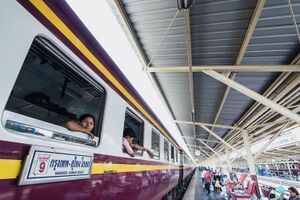
Labor unions are highly illegal in Thervala due to their association with socialist and communist movements. There are, however, very strict labor and safety laws that are enforced as much as possible. These are more prevalent in more urban areas, as rural areas do not have the administrative presence for such things to be enforced.
Transportation
The Kingdom of Thervala has a very comprehensive rail network, with access to each major city within the 10 provinces of the country. Within each city major city there are also large, extended urban metro lines. Designers and engineers were hired from Oyashima to help design these networks. Within the inner Ther peninsula, there is also a network of ferries dedicated to taking people between islands as well as to and from the mainland.
Technology
Thervala has historically had to rely on more advanced, foreign powers for its technological advancements. It is able to currently maintain a modern level of technology due to its proximity to Oyashima and close ties with Burgundie. Rural Thervala is incredibly technologically stagnant, though, and does not enjoy many of the luxuries of the Ther urban centers.
Military

The Kingdom of Thervala's military is a large and elite force. It has served alongside the Burgoignac military in every major armed conflict since the 1500's and has thus maintained a very experienced body of troops. It is the military's responsibility to act as law enforcement within the civilian sector as well as to protect the monarchy. The King and relatives of the king also precede over their own regiments within the military. Membership in such regiments is considered to be a highly esteemed honor.
Membership within the Ther military is highly sought after, due to its boons in regards to social mobility and education. Recruits are typically picked from high schools around the nation, and recruitment officers tend to make their decisions based off of academic merit as well as physical prowess. As such, high school sports teams tend to yield the highest amount of recruits into the military.
Officers within the Ther military are virtually all enlisted men that have served long enough to have enough experience for the role. There do exists programs within Ther universities for Officers to be recruited from student bodies. These officers, however, are few and far between.

